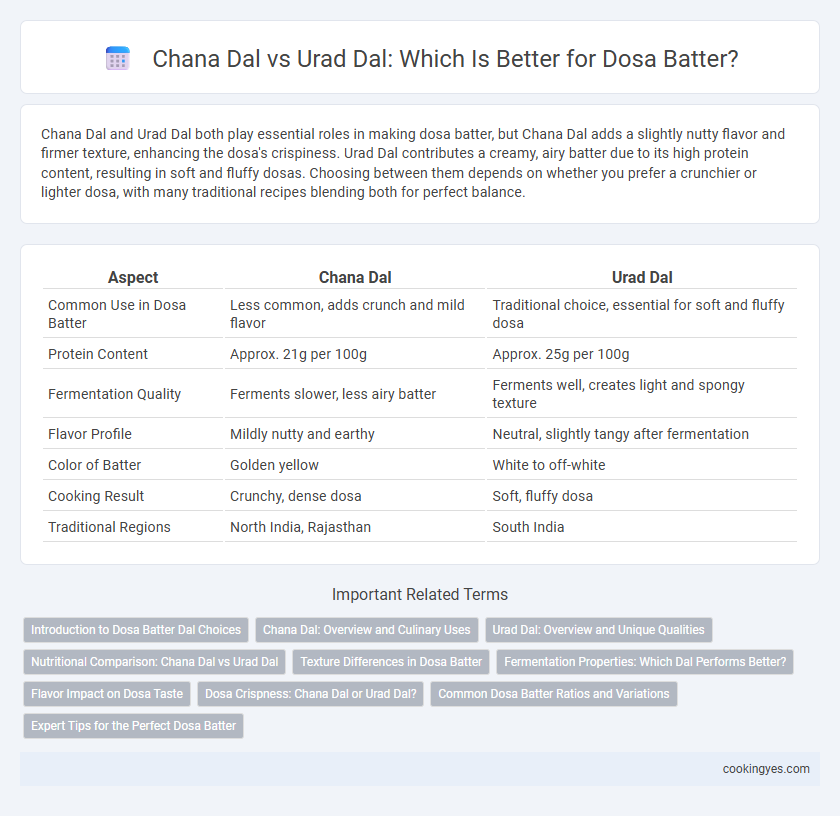Chana Dal and Urad Dal both play essential roles in making dosa batter, but Chana Dal adds a slightly nutty flavor and firmer texture, enhancing the dosa's crispiness. Urad Dal contributes a creamy, airy batter due to its high protein content, resulting in soft and fluffy dosas. Choosing between them depends on whether you prefer a crunchier or lighter dosa, with many traditional recipes blending both for perfect balance.
Table of Comparison
| Aspect | Chana Dal | Urad Dal |
|---|---|---|
| Common Use in Dosa Batter | Less common, adds crunch and mild flavor | Traditional choice, essential for soft and fluffy dosa |
| Protein Content | Approx. 21g per 100g | Approx. 25g per 100g |
| Fermentation Quality | Ferments slower, less airy batter | Ferments well, creates light and spongy texture |
| Flavor Profile | Mildly nutty and earthy | Neutral, slightly tangy after fermentation |
| Color of Batter | Golden yellow | White to off-white |
| Cooking Result | Crunchy, dense dosa | Soft, fluffy dosa |
| Traditional Regions | North India, Rajasthan | South India |
Introduction to Dosa Batter Dal Choices
Chana dal and urad dal are essential lentils used in dosa batter preparation, each imparting distinct textures and flavors. Chana dal provides a mildly nutty taste and a denser batter, contributing to crispier dosas, while urad dal offers a softer, airy batter with excellent fermentation properties. Combining both lentils balances the dosa's crispiness and fluffiness, optimizing taste and nutritional content.
Chana Dal: Overview and Culinary Uses
Chana Dal, derived from split chickpeas, is a rich source of protein and dietary fiber, making it ideal for dosa batter due to its ability to ferment well and impart a slightly nutty flavor. Unlike Urad Dal, which provides a light and fluffy texture, Chana Dal enhances the crispiness and adds a subtle earthiness to the dosa. Its culinary uses extend beyond dosa batter, frequently appearing in soups, stews, and Indian snacks like vada, showcasing its versatility in traditional cuisine.
Urad Dal: Overview and Unique Qualities
Urad Dal, also known as black gram, is a key ingredient in dosa batter, prized for its ability to ferment and create a light, airy texture in dosas. Unlike Chana Dal, Urad Dal has a higher protein and starch content that facilitates better aeration and fermentation, resulting in crispier and softer dosas. Its unique qualities include enhancing batter consistency and promoting the growth of beneficial bacteria, which improves flavor and digestibility.
Nutritional Comparison: Chana Dal vs Urad Dal
Chana Dal provides higher protein and fiber content compared to Urad Dal, supporting better digestion and muscle repair in dosa batter. Urad Dal is richer in iron and calcium, enhancing bone health and energy levels in the final dish. Both dals contribute essential B vitamins, but the choice depends on specific nutritional goals like higher protein intake or improved mineral absorption.
Texture Differences in Dosa Batter
Chana Dal in dosa batter creates a coarser texture with a slightly grainy finish, providing a hearty bite and distinct crunch in the final dosa. Urad Dal produces a smoother, creamier batter that ferments well, resulting in dosa with a light, airy texture and delicate crispness. Combining both dals balances the dosa texture, offering a perfect blend of crunch and softness.
Fermentation Properties: Which Dal Performs Better?
Chana Dal and Urad Dal have distinct fermentation properties impacting dosa batter quality, with Urad Dal traditionally preferred for its superior microbial activity that enhances batter rise and texture. Urad Dal's higher protein content and specific enzyme profile promote faster and more consistent fermentation, resulting in a light, airy dosa with optimal tanginess. In contrast, Chana Dal ferments more slowly, often leading to denser dosa batter lacking the characteristic fluffiness achieved with Urad Dal.
Flavor Impact on Dosa Taste
Chana Dal imparts a nutty and slightly sweet flavor to dosa batter, enhancing the overall taste with a mild earthiness that balances well with spices. Urad Dal contributes a creamy texture and a subtle tanginess, creating a light, fluffy dosa with a distinctive fermented aroma. Combining both dals in dosa batter creates a harmonious blend of richness and tang, elevating the dosa's flavor complexity and mouthfeel.
Dosa Crispness: Chana Dal or Urad Dal?
Urad dal is traditionally preferred for dosa batter due to its ability to create a light, airy texture that contributes significantly to dosa crispness. Chana dal, while adding a nutty flavor and slight firmness, tends to produce a denser batter that results in less crispy dosas. For optimal dosa crispness, urad dal's high protein content and fermentation properties make it the superior choice.
Common Dosa Batter Ratios and Variations
Chana dal and urad dal both serve as essential ingredients in dosa batter, with common ratios involving 3 parts rice to 1 part dal for optimal fermentation and texture. Using urad dal typically results in a smoother, fluffier batter due to its higher protein content, while chana dal adds a nutty flavor and slightly denser texture. Variations often mix 1/4 to 1/3 portion of dal in the batter, balancing taste and crispness according to regional preferences and desired dosa thickness.
Expert Tips for the Perfect Dosa Batter
Chana Dal and Urad Dal both are traditional dals used in dosa batter, each contributing unique textures and flavors, with Urad Dal providing the necessary fermentation power and softness, while Chana Dal adds crunch and a slight nuttiness. Expert tips recommend soaking Urad Dal longer (6-8 hours) to achieve a fluffy, airy batter, whereas Chana Dal requires shorter soaking (4-5 hours) to maintain proper consistency without overpowering the batter's fermentation. Balancing these dals in a 3:1 ratio (Urad Dal to Chana Dal) ensures an ideal dosa batter that ferments well, crisply cooks, and delivers a balanced taste and texture.
Chana Dal vs Urad Dal for Dosa Batter Infographic

 cookingyes.com
cookingyes.com